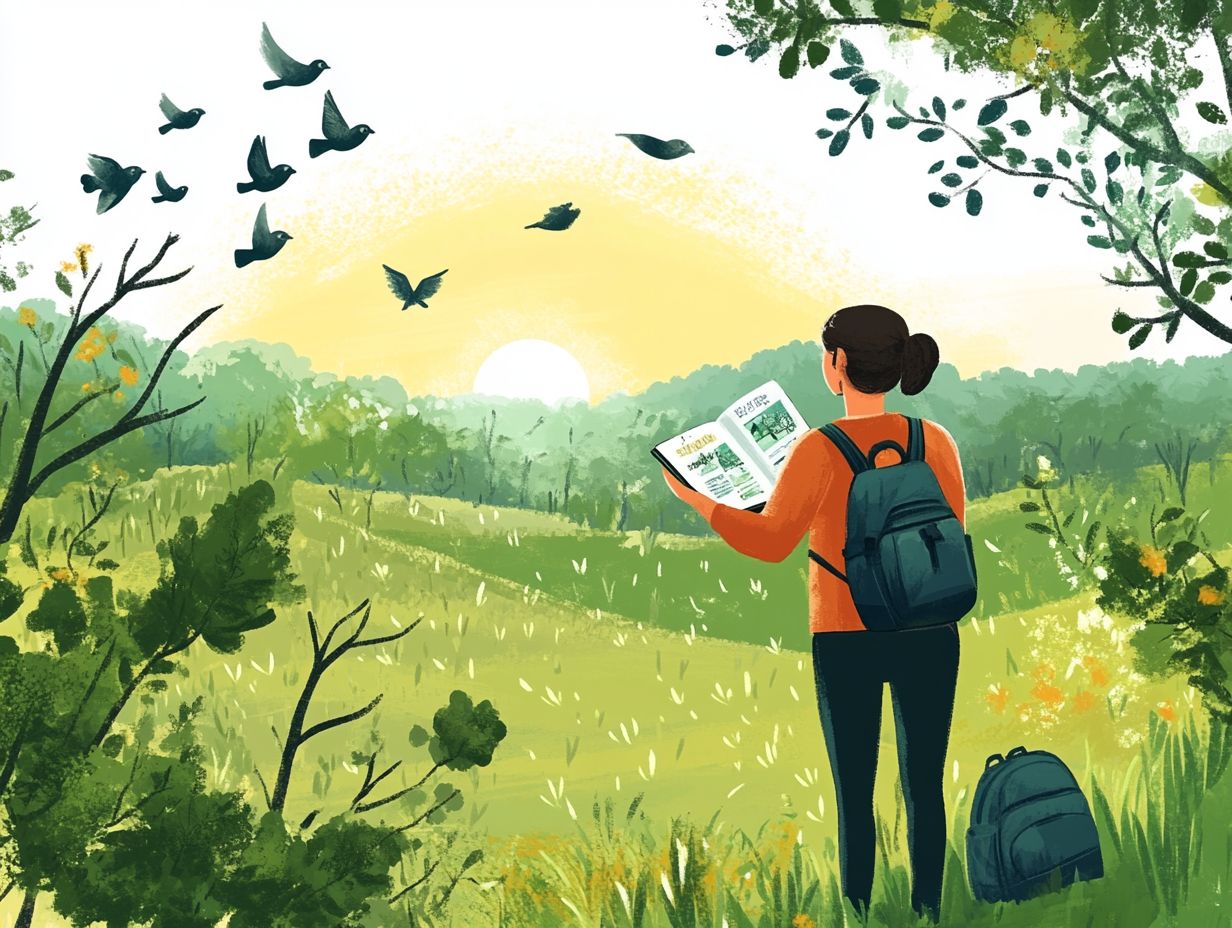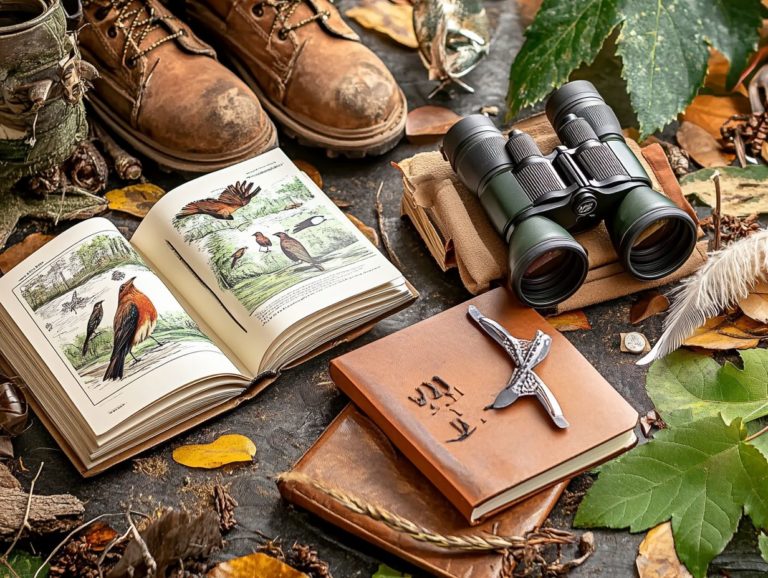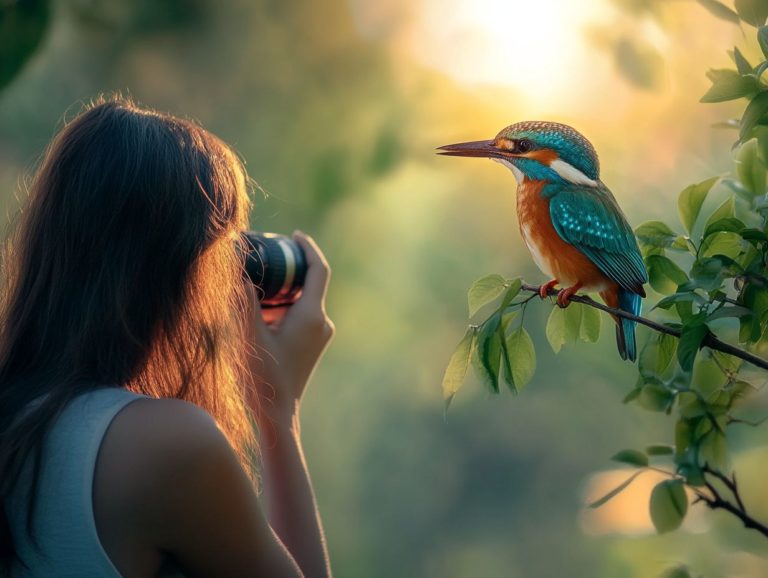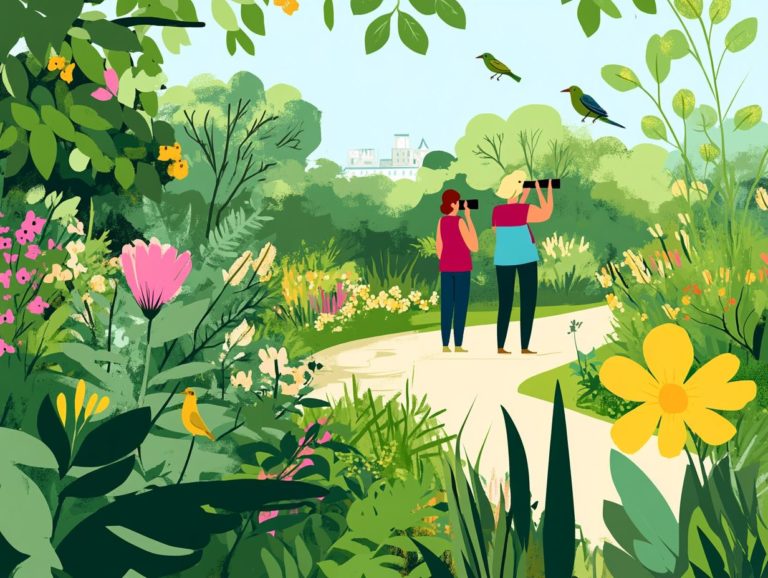How to Prepare for a Bird Watching Trip?
Birdwatching is more than just a hobby. It’s a fantastic way to connect with nature and enjoy the captivating behaviors of our feathered friends.
Whether you’re an experienced birder or just starting out, having the right gear and choosing the perfect location are key for a rewarding experience.
This guide covers the essential gear you’ll need and offers tips for identifying birds. You ll also find birding etiquette to follow as you dive into this fulfilling pursuit.
Get ready to take your birdwatching adventures to new heights!
Contents
- Key Takeaways:
- Essential Gear for Birdwatching
- Choosing the Right Location
- Identifying Birds in the Field
- Etiquette and Ethics in Bird Watching
- Preparing for Outdoor Conditions
- Recording and Sharing Your Observations
- Frequently Asked Questions
- What is the best time of year to go birdwatching?
- What must-have gear do I need to bring on a bird watching trip?
- What safety precautions should I take while bird watching?
- How can I find the best bird watching spots?
- What should I do if I see an injured bird while on a bird watching trip?
- Is it necessary to have a guide for a bird watching trip?
Key Takeaways:

- Pack essential gear like binoculars, field guides, travel equipment, and proper clothing to enhance your birdwatching experience.
- Consider location, season, and habitat for a successful birdwatching trip.
- Respect wildlife and their habitats. Follow proper etiquette while observing and recording bird sightings.
What is Birdwatching?
Birdwatching, or birding as it s affectionately known, invites you to observe and identify various bird species in their natural habitats. This captivating activity has grown in popularity among wildlife enthusiasts and travelers alike.
With tools like field guides and birdwatching apps such as eBird and Merlin Bird ID, you can track your observations and gain a deeper understanding of global bird diversity.
The joy of birdwatching goes beyond observation; it plays a vital role in conservation efforts. It inspires appreciation and protection of avian habitats.
As you explore renowned birding hotspots, you ll find joy in birding tours and local guides that enhance the experience. These communities thrive on sharing tips that enrich everyone s knowledge.
Digital resources make it easier to identify species and understand their behaviors. Engaging with these platforms fuels your passion for nature and highlights the importance of protecting bird populations.
Essential Gear for Birdwatching
When you’re preparing for a birdwatching trip, having the right essentials you need is vital for a great experience, including understanding best practices for bird watching.
Quality binoculars, comprehensive field guides, and reliable photography equipment are key components that enhance your ability to observe and document avian wildlife. Additionally, knowing how to stay comfortable while bird watching can greatly improve your experience in the field.
Using a checklist and birdwatching apps can simplify your preparations and help you keep track of your encounters as you explore exciting locations around the world. Additionally, knowing how to take photos while bird watching can enhance your experience even further.
Binoculars, Field Guides, and Other Necessities
Choosing the right binoculars and field guides can truly elevate your birdwatching experience. Additionally, having the top 10 must-have items for bird watching trips can help you identify birds better and hone your observation skills, which are invaluable for documenting wildlife experiences during your travels.
When you are on the hunt for binoculars, consider options with various magnification levels (how much closer you can see an object) and objective lens sizes (which affect the amount of light that enters the binoculars). These features significantly impact clarity and brightness crucial for spotting those elusive birds in all kinds of lighting conditions.
While traditional field guides have their timeless charm, birdwatching apps are the modern-day companions that every enthusiast should embrace. They offer interactive maps, real-time identification, and community-sourced data on sightings. With these apps, you can easily document your adventures and discoveries!
When traveling, you will want gear recommendations tailored to specific environments. This ensures you are well-equipped for every outing whether you are exploring a local park or venturing into remote wilderness.
Choosing the Right Location
Choosing the right location for birdwatching is essential for immersing yourself in a rich tapestry of diverse species and enhancing your wildlife encounters. Each environment whether it s coastal regions, tropical rainforests, or wetlands presents unique opportunities to observe an array of avian life.
Participating in birding tours led by local experts deepens your understanding of the ecosystem and reveals the prime spots for observing specific species during your travels.
Factors to Consider for a Successful Trip

When you set out on a birdwatching adventure, there are several factors to consider that can significantly enhance the success of your trip. One important aspect is knowing what to look for in bird watching gear. Careful trip planning and budgeting are essential, allowing you to allocate resources effectively for excursions and potential guided tours.
Pay attention to when birds move from one place to another during different seasons, the expertise of local guides, and the available wildlife experiences; these elements can greatly improve your chances of spotting rare and diverse bird species.
Being mindful of your equipment needs, like high-quality binoculars and comprehensive field guides, can truly elevate your enjoyment of the experience. Additionally, knowing what to keep in your bird watching backpack can enhance your outings. Engaging with knowledgeable local guides offers valuable insights into specific habitats and bird behaviors and deepens your understanding of the avian world.
Consider factors such as travel safety, weather conditions, and even cultural nuances to prepare yourself fully for the journey. By combining budgetary discipline with an open mind and a genuine eagerness to learn, you can maximize your adventure. Don’t miss out on the chance to see these amazing creatures!
Identifying Birds in the Field
Accurate bird identification in the field is a skill you can refine through dedicated practice, the application of diverse tools, and leveraging birdwatching apps. By keenly observing distinguishing features, listening intently to bird songs, and understanding their behavioral patterns, you will enhance your ability to identify various species.
Engaging with local guides and embracing ethical birding practices will deepen your appreciation of avian wildlife. This enriches your birdwatching experience while promoting responsible stewardship of these magnificent creatures.
Tips for Accurate Identification
To achieve precise bird identification, mix visual and auditory cues with thorough research and reliable reference materials. Understanding bird songs and calls can vastly enhance your ability to recognize species, even before you see them.
Using field guides and seeking insights from local experts will provide you with invaluable knowledge about the unique characteristics of birds in your area. This includes insights from local guides and their expertise on avian wildlife.
This dual approach broadens your skills and deepens your appreciation for avian diversity. Pay close attention to feather patterns, beak shapes, and habitat preferences to complement your auditory training.
Engaging with community birdwatching groups exposes you to a wealth of shared knowledge, transforming your learning into something interactive and enjoyable.
Recording your observations helps track your progress and refine your skills by collaborating with bird groups. By marrying auditory recognition with keen observation and localized research, you fully immerse yourself in the captivating world of ornithology (the study of birds).
Etiquette and Ethics in Bird Watching
Understanding and embracing etiquette and ethics in birdwatching is essential for preserving wildlife, fostering respectful interactions with birds and their habitats, and enhancing your experience in the field.
As a birder, prioritize the wellbeing of avian wildlife. Remember to use ethical guides, maintain a respectful distance, minimize disturbances, and adhere to local regulations.
By collaborating with ethical guides and sharing valuable birding tips, you contribute to a community that emphasizes conservation and promotes exciting outdoor adventures for all enthusiasts along the way.
Respecting Wildlife and Their Habitats
Respecting wildlife and their habitats is a fundamental principle of responsible birdwatching that you should embrace wholeheartedly. Minimize disturbances to natural environments and follow conservation practices to help protect the delicate balance of ecosystems.
Using ethical guides and following birding tips fosters sustainable practices that benefit both avian wildlife and your future birdwatching experiences.
This approach enriches your experience and deepens your appreciation for the natural world, especially when engaging in citizen science initiatives. Contribute to conservation efforts by supporting organizations dedicated to protecting habitats.
Maintaining a respectful distance from nests and using binoculars instead of getting too close minimizes stress on these creatures and their environments. Adhering to locally established guidelines further highlights the importance of being a mindful steward of the land, ensuring a sustainable birdwatching experience.
By championing these responsible practices, you play a vital role in ensuring that birdwatching remains a sustainable pursuit for generations to come while exploring the diverse species that inhabit our planet.
Preparing for Outdoor Conditions

Preparing for outdoor conditions is crucial for a rewarding birdwatching experience, as the ever-changing weather and terrain can greatly influence your outdoor adventure. It’s also important to know what equipment is essential for bird watching to enhance your experience.
Familiarizing yourself with the climate and seasonal patterns of your chosen birding location empowers you to pack the right clothing and gear, enhancing your birding trips.
By documenting your preparations in a travel journal and thoughtfully planning your excursions, you can elevate your comfort and maximize your enjoyment while observing birds in their natural habitats. For instance, consider what to keep in mind when bird watching alone, including tips for coastal and tropical regions.
Weather, Terrain, and Other Considerations
Weather and terrain play pivotal roles in shaping your birdwatching experience, so it’s essential to consider these factors while planning your trip. For those interested in exploring this activity further, check out how to start bird watching as a hobby.
Understanding weather changes throughout the year and the specific terrain of your chosen location will equip you to tackle outdoor conditions with confidence. This knowledge allows for better navigation during your birding tours.
Local guides are a treasure trove of information. They offer insights into the best times and spots for birdwatching, as well as valuable tips on bird identification and observing birds. This ensures your adventure in nature is both successful and enjoyable!
For example, if you venture into marshy areas during the rainy season, you might encounter different species than you would in dry landscapes. This underscores the necessity of checking weather forecasts in advance through online resources.
Varying altitudes can also influence migratory patterns. This makes certain times of year particularly favorable for spotting specific birds.
Team up with local guides for an unforgettable birdwatching adventure! They provide invaluable knowledge about hidden gems and less-traveled areas, enhancing your chances of encountering unique sightings, including rare mammals and birds.
Thoughtful planning elevates not just the experience but also the sheer joy of connecting with the natural world and its avian inhabitants.
Recording and Sharing Your Observations
Recording and sharing your observations is essential to the art of birdwatching. It allows you to document your experiences and track species. It also contributes to vital conservation efforts and encourages the use of birdwatching apps.
By utilizing platforms like eBird, you can effortlessly log your sightings and compare them with community trip reports. This fosters a sense of collaboration among fellow birders.
Moreover, photography enhances your wildlife experiences. It enables you to share your adventures with others and inspire the next generation of birdwatchers! Encourage them to explore local and international destinations like Ecuador and Oman.
Tools and Platforms for Sharing Your Birdwatching Experience
Utilizing tools and platforms like eBird can elevate your birdwatching experience dramatically. You can share your observations and connect with fellow enthusiasts while benefiting from detailed birding tips.
These online resources make it easy for you to log your sightings, access trip reports, and collaborate on conservation efforts. This ensures a comprehensive overview of bird diversity in different regions.
Incorporating photography into your adventures adds a captivating visual element to your records. This transforms your birdwatching journey into something truly engaging and inspiring, which can also help in identifying birds.
Contributing to communities on platforms such as BirdForum or dedicated social media groups allows you to exchange insights and tips about your favorite birding spots. You can share checklists and other resources with fellow birders.
Engaging with detailed trip reports not only sparks inspiration for your future outings but also cultivates a sense of camaraderie among fellow birdwatchers, enhancing your overall wildlife experiences.
Using apps designed for bird identification further enhances your experience. It simplifies recognizing species and allows you to share your sightings seamlessly, which is essential for effective trip planning.
These collective efforts not only enrich your personal journey but also contribute to broader conservation databases. This ultimately plays a vital role in protecting avian populations and fostering a deeper appreciation for wildlife.
Frequently Asked Questions
Welcome to our FAQ section! Here, you can find answers to common questions about birdwatching to help you plan your adventures.
What is the best time of year to go birdwatching?

The best time of year to go birdwatching varies depending on the location. Generally, spring and fall are the best times as this is when birds are migrating.
However, for some locations, summer may be the best time to see certain species, particularly in regions like Colombia or Brazil.
Start your birdwatching journey today get outside and start observing!
What must-have gear do I need to bring on a bird watching trip?
The most essential gear for bird watching is a pair of binoculars and a field guide, which is a book that helps you identify different bird species. Additionally, preparing for a bird photography outing with a camera, notebook, and birding app can also be handy.
It’s important to wear comfortable clothing and sturdy shoes for your excursions.
What safety precautions should I take while bird watching?
It s important to respect the birds and their habitats. Do not disturb nesting areas or get too close to birds.
Be aware of your surroundings and avoid potential hazards, such as steep cliffs or poisonous plants. Always practice ethical guidelines during your birding tours.
How can I find the best bird watching spots?
Researching and asking local birding groups or experts can help you discover fantastic spots to go bird watching.
National and state parks, wildlife refuges, and nature reserves are also great places to start your birding expeditions.
What should I do if I see an injured bird while on a bird watching trip?
If you encounter an injured bird, do not try to handle it yourself. Instead, contact a local wildlife rehabilitation center or birding group for assistance.
These experts have the knowledge and resources to care for the injured bird and can offer valuable insights.
Is it necessary to have a guide for a bird watching trip?
A guide is a fantastic resource for both beginners and seasoned bird watchers! They can help with identifying birds, finding the best spots, and providing valuable information about the birds and their habitats.
This enhances your overall birdwatching experience.
So, grab your binoculars and start planning your adventure today!






